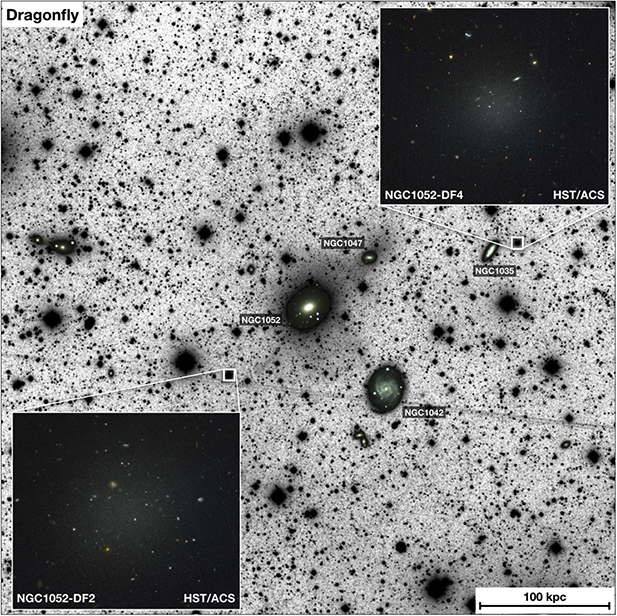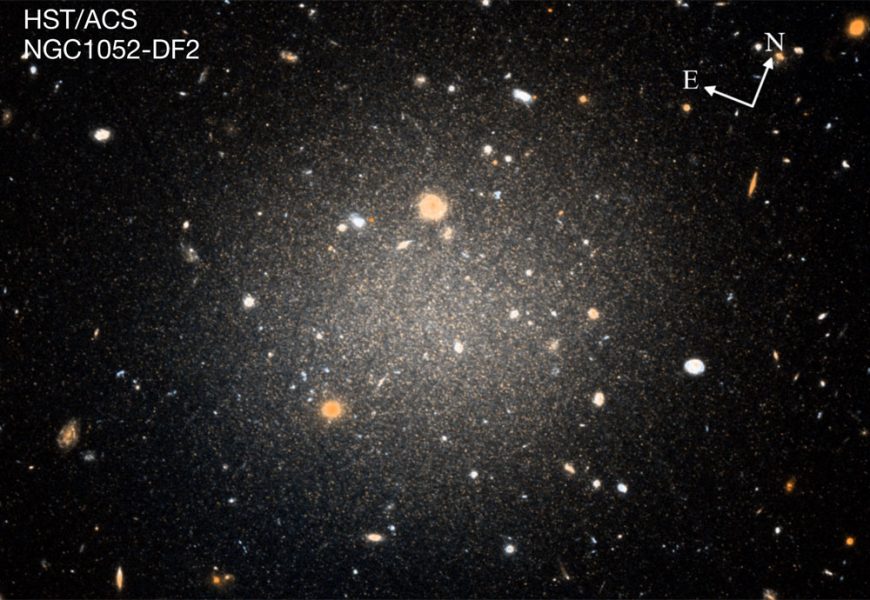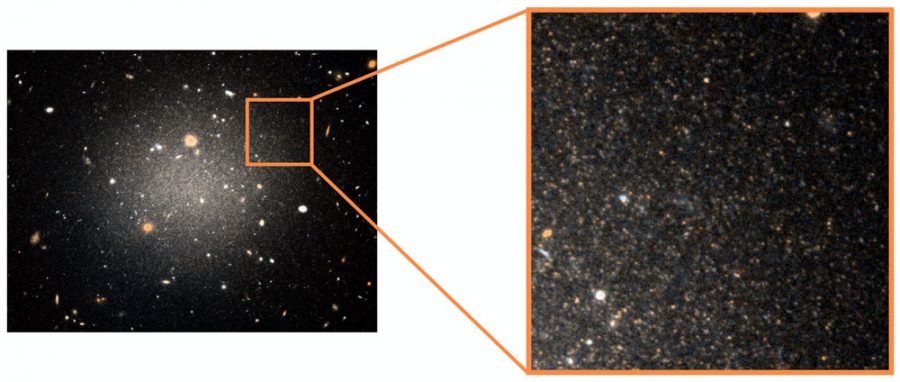New distances to two dwarf galaxies with unusually spread-out stars support the idea that these galaxies have little to no dark matter.
New distance measurements of two strange galaxies in the constellation Cetus, the Whale, support the notion that they are almost devoid of dark matter — the mysterious stuff that constitutes 85% of all gravitating mass in the universe. Astronomers are at a loss to explain the apparent absence of dark matter in the two systems.

P. van Dokkum (Yale University) / STScI / ACS
NGC 1052-DF2 and -DF4 (named after the Dragonfly Telephoto Array in New Mexico that imaged the objects) are prime examples of ultra-diffuse galaxies. They contain relatively few stars spread out over a large volume, making them hard to detect. On the sky, the two faint smudges are close to NGC 1052, the largest member of a small galaxy group between 63 and 70 million light-years away.
If DF2 and DF4 are at a similar distance, measurements of the velocity spread of their member stars and orbiting globular clusters indicate total galaxy masses that are in good agreement with the observed number of stars. This suggests that their dark matter fraction is a few percent at most, an oddity compared to most galaxies whose total mass is dominated by dark matter. Another puzzling thing is that the globular clusters of the two ultra-diffuse galaxies are exceptionally luminous.
The initial findings by the Dragonfly team, published in 2018 and 2019, were challenged by Ignacio Trujillo (Astrophysical Institute of the Canary Islands) and his colleagues. They argued that the two galaxies are much closer, about 42 million light-years away, based on archival observations of the constituent stars. In that case, there would be “plenty of room for dark matter”, the researchers wrote, and the globular clusters would have a normal luminosity.

Z. Shen et al. / arXiv
However, new, dedicated Hubble Space Telescope observations of DF2 and DF4 now seem to support the original claims made by the Dragonfly team. Hubble imaged many thousands of individual red giant stars in the outer parts of both galaxies. The brightest red giant stars in any galaxy have a well-defined luminosity, so measuring the apparent brightness of this “tip of the red giant branch” (TRGB) provides an estimate of the stars’ distance.
Shany Danieli (Yale University) and her colleagues published initial results for DF4 last year in Astrophysical Journal Letters. A team led by Zili Shen (also at Yale) posted much deeper observations of DF2 April 9th on the arXiv preprint server. The TRGB measurements indicate a distance of 65.2 million light years for DF4 and 72.0 million light-years for DF2. The researchers describe the distance as “definitive.”

Z. Shen et al. / arXiv
However, Trujillo is not yet convinced. In particular, he notes that Danieli, Shen, and their colleagues have omitted the innermost parts of the two galaxies in their analysis. “These regions contain 50% of the stars,” he says. “They should not have been thrown away so easily.” Trujillo also fears that the team's analysis has misidentified the true tip of the red giant branch.
Moreover, Trujillo's team has claimed the discovery of tidal streams of stars streaming away from DF4, suggesting gravitational interactions with another galaxy, NGC 1035, which is some 45 million light-years away.
If the larger distances for the two ultra-diffuse galaxies stand the test of time, astronomers will have to explain how a galaxy can lose almost all of its dark matter. The velocity measurements of DF2 and DF4 would even potentially pose a problem for MOND (Modified Newtonian Dynamics), which tries to explain away dark matter by introducing an alternative description of gravity. If MOND is correct, each and every galaxy should behave as if it contained loads of dark matter.
MOND theorists note that the “MONDian” gravitational field of NGC 1052 would affect the dynamics of nearby DF2 in more or less the right way as to explain the velocity measurements. However, that leaves DF4 unexplained: The new Hubble observations indicate that DF2 and DF4 are pretty far apart from each other, so they can’t both lie in the larger galaxy’s sphere of influence.
The two recent papers “are a useful addition to the distance discussion using deeper data,” says Trujillo’s colleague Michael Beasley. “However, I am sure that they are not the last word on the matter.” It may take future observations by the James Webb Space Telescope to settle the issue once and for all.
 7
7









Comments
Gerald-Hanner
April 14, 2021 at 3:21 pm
It seems that Dark Matter is a crutch to account for widely diffused normal matter the is essentially undetectable.
You must be logged in to post a comment.
Bob-dBouncier
April 16, 2021 at 9:50 am
Yeah, but Dark Matter sounds so much cooler than Ether.
You must be logged in to post a comment.
Anthony Barreiro
April 14, 2021 at 7:09 pm
DF-2 and DF-4 might be hard to see, but at magnitude 10.4 NGC 1052 would be easily visible through amateur telescopes, and easy to find 4 degrees west of 4th magnitude Eta Eridani. Unfortunately that stretch of Eridanus is currently conjunct the Sun, so we'll have to wait until dawn in September to have a look.
You must be logged in to post a comment.
Andrew James
April 14, 2021 at 8:42 pm
The central point is this well studied group of galaxies now discounts earlier papers which assumed the bridge between DF2 and DF4 is truly association with NGC 1052. As for MOND, NGC 1052 has been used as a test case for dark matter, now unlikely to help, but this hardly eliminates that global idea that galaxies might 'pool' dark matter. I think this paper mostly highlights the stringency required in improving galaxy distances to constrain adopted theory - nothing more.
You must be logged in to post a comment.
Andrew James
April 14, 2021 at 8:46 pm
Your statement. "The TRGB measurements indicate a distance of 65.2 million light years for DF4 and 72.0 million light-years for DF2. The researchers describe the distance as “definitive.” "
These distances in the paper are expressed in megaparsecs or Mpc not million light years. It is expressed as relative distance as delta D as 2.1+/-0.5Mpc. or 6.9+/-1.6 Mly.
You must be logged in to post a comment.
Peter Wilson
April 16, 2021 at 9:59 am
Why bother modifying Newtonian gravity?
We already know it is deficient on two grounds, which Einstein "fixed." Modifying Newtonian gravity is going backwards.
You must be logged in to post a comment.
Andrew James
April 17, 2021 at 12:08 am
Could it be that MOND successfully predicts some of observed galactic phenomena? eg. galaxy rotation curves? Sure, MOND has some complicated issues which are limited by measuring its effects, but evidence finds dark matter is likely the cause. Even if hypothesis like emergent or entropic gravity were completely rejected, these effects remain significant. That you are unable to supply any supporting evidence for broad-stroke statements made above, mean you opinion must be taken with a grain of salt.
You must be logged in to post a comment.
You must be logged in to post a comment.